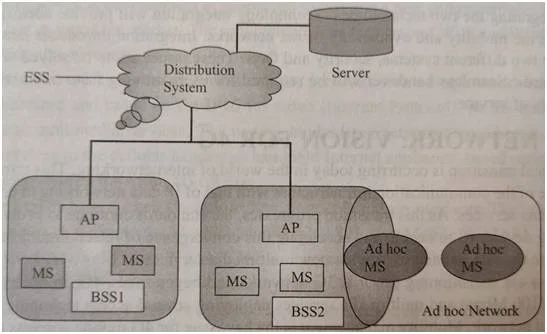What is 802.11b Standard ?
IEEE 802.11b is a wireless networking standard which operates in 2.4 GHz frequency band. It is released in 1999. The 802.11b standard offers maximum theoretical data rate of 11 Mbps. Practically 802.11b supports data rates in the range from 4 to 6 Mbps due to various overheads, interference and other factors. 802.11b standard based products have become outdated as it is significantly slower compared to latest Wi-Fi standards such as 802.11g, 802.11n, 802.11ac (wifi 5), 802.11ax (Wi-Fi 6) and 802.11be (WiFi 7).
802.11 b Network Architecture:
We will see in this section 802.11 network architecture. An 802.11 LAN is based on a cellular architecture where entire system is subdivided into cells, where each cell(called BSS or Basic Service Set) is controlled by a Base Station( called AP or Access Point in WLAN terminology). Usually WLAN may be formed by a single cell and each cell has single AP but most installations will be formed by several cells where APs are connected through some kind of backbone (called DS or Distributed System), typically Ethernet, and in some cases wireless itself. These interconnected WLAN including cells, their APs and DS is seen to the upper layers of the OSI model as single 802 network, and is called as ESS (Extended Service Set(.

WLAN network Types are infrastructure and adhoc.
1. Infrastructure type can be formed by Access Point(AP) and station.Also referred as BSS network.
2. Ad-hoc type formed by two or more Stations(STAs).Also referred as IBSS network.
These network does not include DS(distribution system). MS in the diagram refers to Mobile Subscriber or Mobile Station (STA).
As mentioned in the figure above each STA or AP will mainly composed of two layers PHY and MAC. MAC helps in establishing the connection between AP and STA or STA and STA based on network type. There are various messages for the same. These messages are categorized into control, management and data. Data frames are used for data transmission. Control frames are used to control access to the medium (e.g. RTS, CTS and ACK). Management frames are used to exchange management information and are not forwarded to upper layers. CSMA-CA is used as protocol to gain access to the medium. List of MAC frames include Authentication, Association, De-authentication Disassociation, Distribution, Integration, Privacy, Re-association etc. Each MAC frame is differentiated by type and subtype fields.
PHY layer make MAC frame compatible to be transmitted over the air and helps recover the data at the other end after it is corrupted by the medium. 802.11 families use two main Physical layer modes viz. OFDM and DSSS/CCK. 802.11b use the succeeding type. 802.11b supports 1, 2, 5.5 and 11Mbps data rates. Other data rates are supported by OFDM Physical layer modes. Refer our article on 11a OFDM PHY to know more on the subject. Based on data rate different PHY layer parameters are set.

Table mentions different types of data rate along with modulation types supported in IEEE 802.11b Physical layer. Refer CCK vs DSSS vs OFDM >> which describes CCK, DSSS and OFDM modulation techniques used in WLAN to achieve different data rates.
802.11 b Physical layer
802.11 b standard Physical layer is composed of two parts transmitter and receiver as mentioned below.

11b Physical layer packet is composed of three parts PLCP preamble, PLCP Header and Data (PSDU). Each Packet is called PPDU. There are two PPDU defined by 11b standard Long PPDU and Short PPDU.

As mentioned in the 11b PHY Transmitter Block schematic MAC data is passed from scrambler, modulator and pulse shaping filtered. Based on the data rate different schemes are set as mentioned in the table above. The same is later interfaced to RF module and up converted to RF Frequency of 2.4GHz before transmission to air using dipole antenna. Similarly on the receive side corrupt RF packet is received, which is filtered and passed onto time and frequency synchronizer. The same is later down sampled based on the rate selected on transmit side and will be channel equalized.
802.11 b frame structure
IEEE 802.11 b frame structure consists of preamble, header and data part. Preamble is used for time/frequency synchronization and channel correction. Header is decoded which will reveal modulation/data rate information of Data part (PSDU). Hence data part is also decoded using this vital information. This data is passed to the MAC layer for further processing/action.
The 802.11b standard has been outdated but it might have specific use cases in certain non-wifi systems. The latest wifi standards support legacy 802.11 b fall back as some older devices or systems might only support 802.11b.
Similar posts on Physical layers
Similar posts on 802.11 WLAN MAC
WLAN authentication Request and deauthentication frame
WLAN beacon frame
WLAN passive vs active scanning frame
WLAN Probe Request and response frame
WLAN reassociation Request and response frame
WLAN RTS and CTS frame
